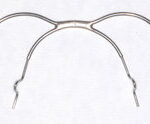About 4.5 million people in the United States are wearing braces right now. Chances are, after they get their braces off, they will need some sort of retainer afterwards. Retainers are made of plastic, metal, or a combination of both to keep your teeth aligned once braces are removed. Just like a snowflake, no two retainers are alike. Your orthodontist will take an impression of your teeth and palate to custom design your new mouth piece for you to wear to make sure your teeth don’t regress back to where they started before getting braces. Some retainers need to be worn nightly for a few months and some need to be worn for life, depending on your treatment plan. Learn about the three different types of retainers and which one might be right for you.
Permanent Fixed Retainer
A permanent fixed retainer is just that — permanent. This means that you will most likely be sporting this fixture for life. Don’t worry just yet, the neat thing about them is they are not visible from the outside. This retainer is a metal wire (or series of metal wires) that is bonded using clear adhesive material to the backside of your teeth. They are most common on people who need lower teeth retainers. A patient’s “bite” may make it more difficult to place on the upper teeth.
I have a permanent fixed retainer on my upper teeth. It is made up of three separate wire fragments that connect five of my front teeth. While I enjoy never having to worry about losing it or it effecting my appearance, this type of retainer makes flossing between my front teeth very difficult, if not impossible. After I had the permanent fixture put in by my orthodontist and later saw my dentist, my dentist warned me that I am very vulnerable to plaque build-up in these teeth and also dental decay. While I brush four times per day and floss daily, I can see that teeth are staining from the fixture is placed.
“Invisible” Retainers
Invisible retainers look a lot like what people know as Invisalign. Your orthodontist will take a cast of your teeth and use that to mold a clear plastic retainer that caps over your teeth. These fixtures need to be removed in order to eat and it is recommended to remove them if you are drinking anything aside from water. These retainers can last for long periods of time – several years or more.
Although they are supposedly “invisible” (hence the quotations), I did not think my retainer was invisible at all. In fact, I thought it was more strange looking and noticeable than braces.Though they are clear, when a stranger is talking to you and glances at your mouth, they can notice something is just not right about the way your teeth look. I’d rather have a stranger know that “something” was a retainer and not a strange tooth deformity or coating. However, this retainer was good at being invisible whenever I lost it – just something to consider!
Hawley Retainers
Hawley retainers are a removable device that is made up of a combination of both plastic and metal. Your dentist will take an impression of your teeth and use the area of the palate to form a plastic mold and then use a metal wire to come up and over the plastic that is supposed to sit across the front-side of your teeth. From a stranger’s point of view, you just have a metal bar running across the front of your teeth — they cannot see the plastic palate piece. They need to be removed when eating or drinking. Unlike the invisible retainer, this type can be adjusted without having to recreate the whole fixture.
This type of retainer was most preferred by my dentist. Although I still have my permanent retainer fixed on the backside of my upper teeth, I still keep my old trusty Hawley in my bathroom cabinet. I keep debating whether I want to have the permanent fixture removed and use my Hawley so I can floss and brush better, but I’m not quite committed to having to remember to keep track of it and wear it wherever I go.
You may want one type of retainer depending on your lifestyle and commitment to keep track of your retainer. There are pros and cons to each type, so take a while to think about each one before jumping the gun. In the end, the Hawley retainer appears to be the best option recommended by dentists for optimal dental health and long-term practicality.

